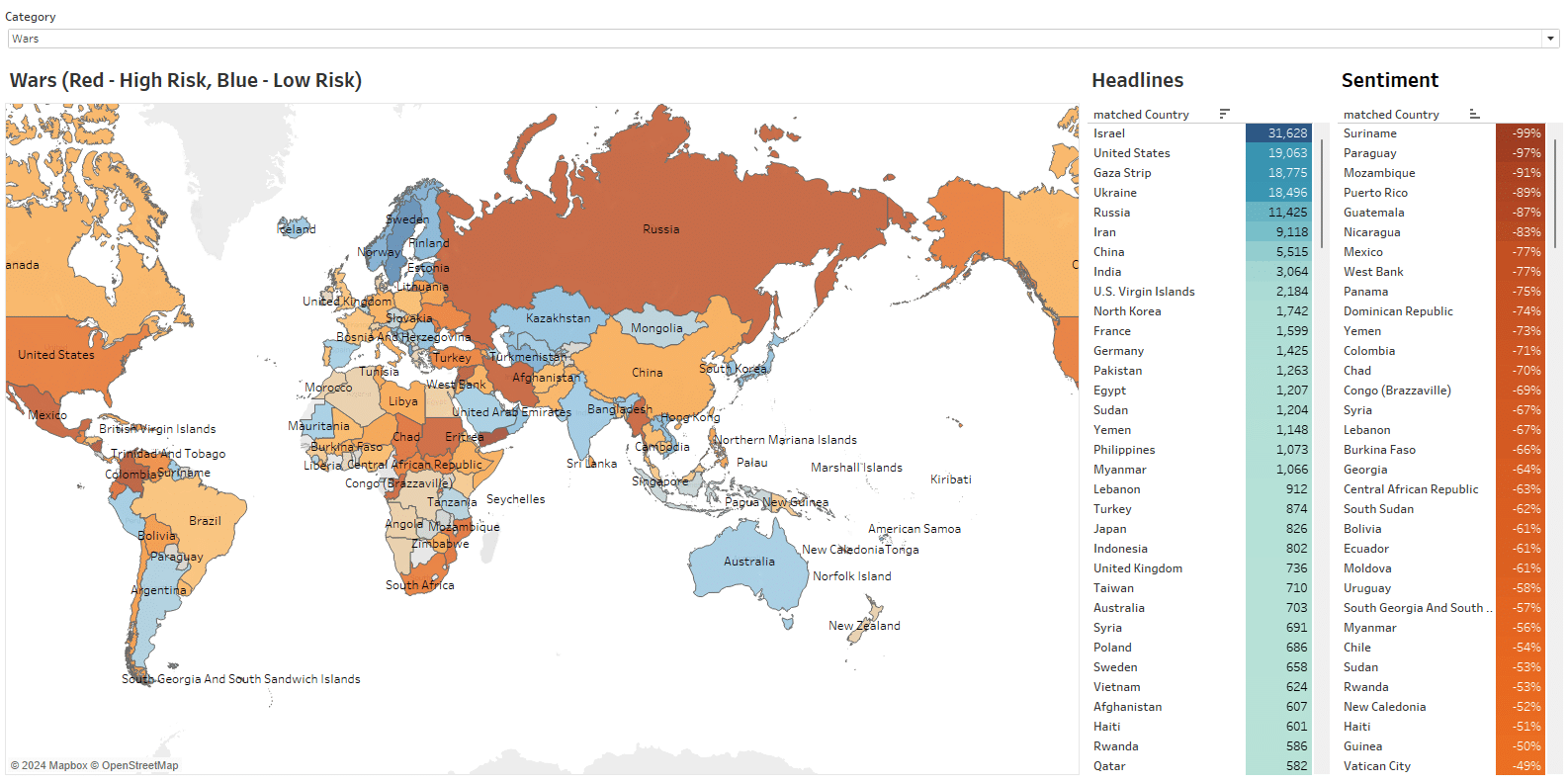The alarm bells of global politics are ringing and the world is starting to listen. It’s an understatement that geopolitical tensions are now shaping the global economy more than ever before. In truth, understanding the dynamics of geopolitical conflicts has become non-negotiable in the world of global business. In this article, we’ll offer a glimpse of how we have been using our AI-driven data analysis to transform how we perceive and respond to international conflicts. Off the back of our advanced AI-driven sentiment analysis tools, we’ll take a closer look at what wars are happening now but also more crucially offer our insightful view into the emotional undertones and public perceptions that underpin news coverage around the world.
Using AI to understanding global sentiments
Let’s briefly look at our methodology. In simple terms, we analyze extensive datasets of global news articles to determine the sentiment and potential risk associated with various geopolitical events. Hence, our analysis is visualized in the above colour-coded heatmap, where colours range from red, indicating high-risk areas, to blue, thus indicating regions of stability. The visualization of our data in this way gives an immediate overview of global conflict zones. The good news here is that it allows researchers, policymakers, and risk advisories and consultant to grasp complex international dynamics swiftly.
What wars are happening now
Our latest heatmap analysis identifies several active conflict zones around the world. Let’s take a look at what wars are happening now below:
-
Middle East:
- Syria: The civil conflict in Syria has emerged as being one of the most complex, with multiple factions and international powers involved.
- Yemen: The trouble in Yemen has resulted in ongoing conflict creating a humanitarian crisis, involving multiple regional actors.
- Israel-Palestine: Almost everyone knows that the conflict between Israel and Palestine has been going on for decades, with the most recent escalation happening in Gaza. This is often referred to as the Gaza War or the Israeli-Palestinian War.
-
Eastern Europe:
- Ukraine: The conflict in Ukraine, especially heightened since 2014, continues to see escalations that involve direct and indirect participation by various international stakeholders.
-
Africa:
- Libya: Libya’s internal divisions have led to ongoing conflicts between rival factions vying for control of the country.
- Sudan: The same applies to the political instability which escalated into open conflict in several regions, complicating the transitional governance phase.
- Ethiopia: The Tigray region has been a focal point of conflict, affecting the broader Horn of Africa.
So there is it. In this light, we can clearly see that the regions highlighted in deep shades of red on the heatmap are not only centres of current military or political conflicts but also represent areas where the news sentiment is highly negative. All of this is highly indicative of ongoing or escalating violence.
The good news is that this contextual and dynamic overview provided by our geopolitical risk analysis tools allows these situations to be monitor closely. All of which provides essential insights for decision-making in policy, humanitarian aid, and security planning. There’s plenty of evidence to suggest that as global dynamics become increasingly volatile, the ability to analyze and interpret vast amounts of data through AI tools like these becomes increasingly important in addressing and understanding the complexities of international conflict, particularly when overlaid over on-the-ground intelligence sources or indeed to provide geopolitical intelligence where there are no feet on the ground.
And if this is the case, and as our sources tell us, by integrating these real-time data visualizations into strategic operations, organizations and governments will be better able to prepare and respond to the global challenges posed by these conflicts.
What wars are happening now: Insights from our global war and conflict heatmap
Predictably, countries in the Middle East and parts of Eastern Europe and Africa are frequently highlighted in red on the heatmap. Expectedly, these areas are often living under the shadow of ongoing conflicts or unstable political landscapes, reflecting intense negative sentiments in news coverage. The concern around nations such as Syria, Ukraine, and Israel are often headline news due to the very persistent strife these countries are tied in with, and are typical examples where our tools detect heightened risk levels.
In stark contrast, countries in Western Europe, North America, and parts of the Asia-Pacific region appear in cooler shades. It is widely acknowledged that these regions generally enjoy political stability and are linked to positive or neutral news sentiments. So far, so predictable. But such distinctions really bring the disparities in peace and conflict across the globe home to roost.
Without a shadow of a doubt, our analysis also points to the blindingly obvious fact that the media plays a major role here in shaping public perception. And this is why negative sentiments prevalent in conflict zones can influence international relations and domestic policies, in a ever-decreasing circle of global diplomacy.
The future of AI in geopolitical analysis
Looking ahead, we plan to continue to refine our algorithms, geopolitical risk data analysis and expand our datasets, aiming to cover more regions and different ways to view our data by working with our test users and clients to refine our offering. And this is why our goal is to create the very best, continuously updated model of global sentiments that can act as an early warning system for potential conflicts using our predictive capabilities. The good news is that integrating machine learning models to predict shifts in sentiment and conflict likelihood based on emerging news trends has the potential to revolutionize preemptive peacekeeping strategies.
Trial our Global Conflict Tracker and World Events data sets
Are you ready to stay ahead in understanding global conflicts and significant world events? Sign up now to trial Permutable AI’s advanced Global Conflict Tracker and access our comprehensive world events data sets. Gain real-time insights and detailed analysis to inform your strategic decisions, policy-making, and risk management and navigate the complexities of international relations with confidence.
